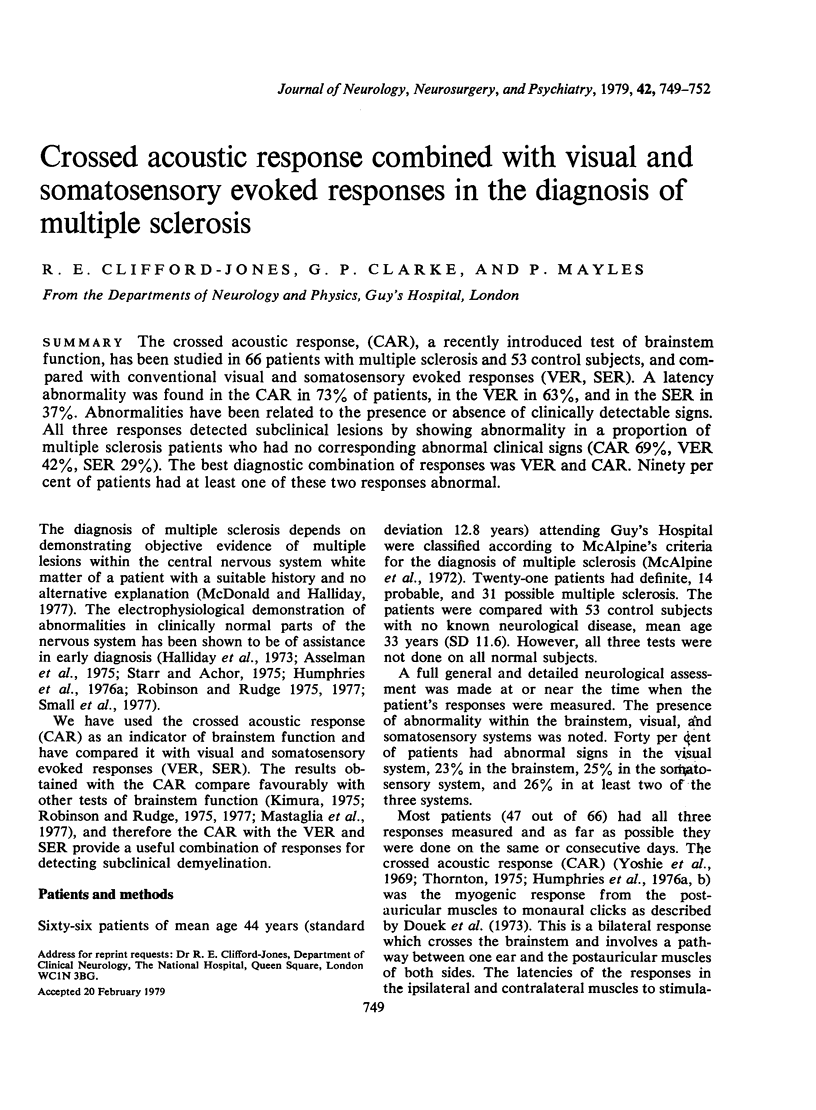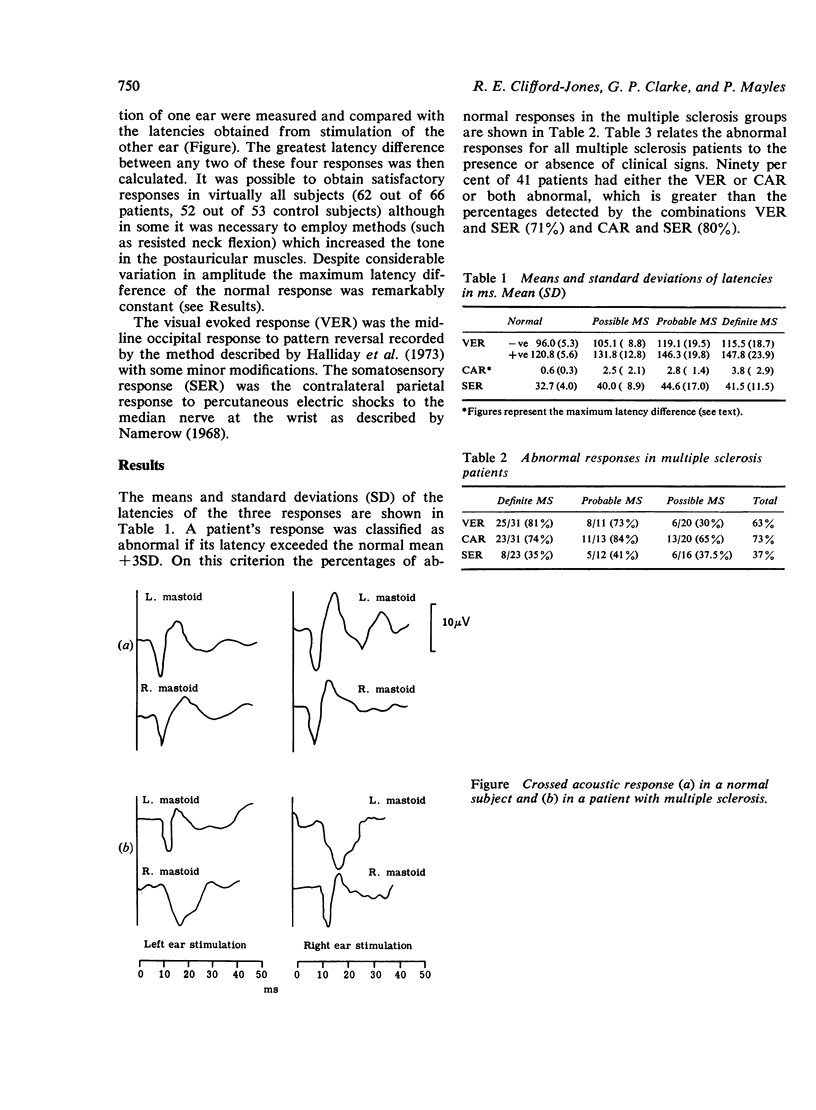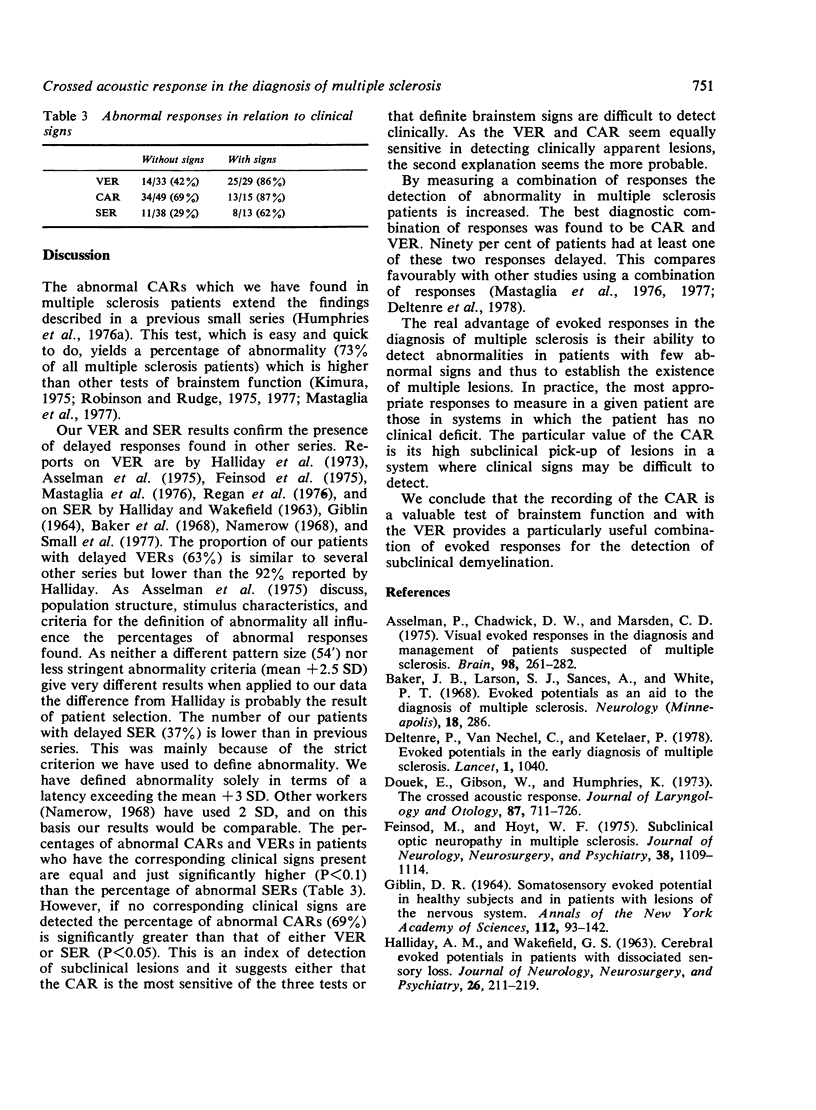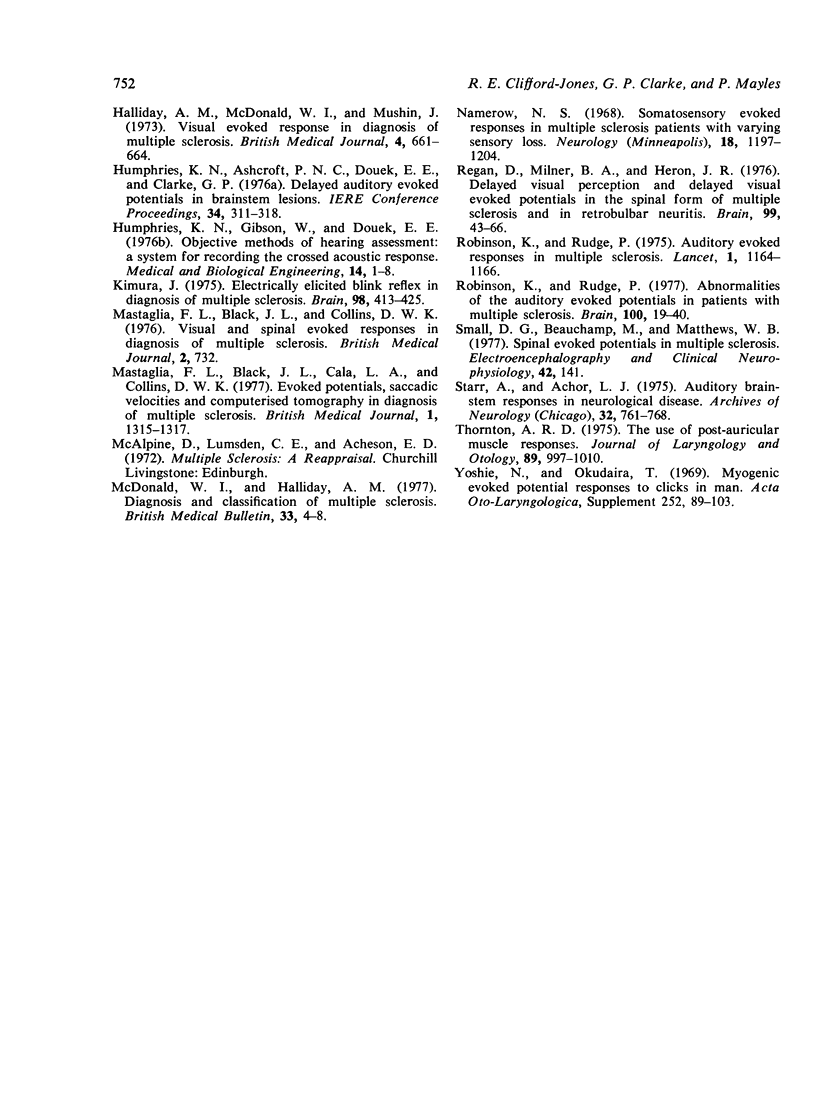Abstract
The crossed acoustic response, (CAR), a recently introduced test of brainstem function, has been studied in 66 patients with multiple sclerosis and 53 control subjects, and compared with conventional visual and somatosensory evoked responses (VER, SER). A latency abnormality was found in the CAR in 73% of patients, in the VER in 63%, and in the SER in 37%. Abnormalities have been related to the presence or absence of clinically detectable signs. All three responses detected subclinical lesions by showing abnormality in a proportion of multiple sclerosis patients who had no corresponding abnormal clinical signs (CAR 69%, VER 42%, SER 29%). The best diagnostic combination of responses was VER and CAR. Ninety per cent of patients had at least one of these two responses abnormal.
Full text
PDF



Selected References
These references are in PubMed. This may not be the complete list of references from this article.
- Asselman P., Chadwick D. W., Marsden D. C. Visual evoked responses in the diagnosis and management of patients suspected of multiple sclerosis. Brain. 1975 Jun;98(2):261–282. doi: 10.1093/brain/98.2.261. [DOI] [PubMed] [Google Scholar]
- Baker J. B., Larson S. J., Sances A., White P. T. Evoked potentials as an aid to the diagnosis of multiple sclerosis. Neurology. 1968 Mar;18(3):286–286. [PubMed] [Google Scholar]
- Deltenre P., Van Nechel C., Ketelaer P. Evoked potentials in the early diagnosis of multiple sclerosis. Lancet. 1978 May 13;1(8072):1040–1040. doi: 10.1016/s0140-6736(78)90760-2. [DOI] [PubMed] [Google Scholar]
- Douek E., Gibson W., Humphries K. The crossed acoustic response. J Laryngol Otol. 1973 Aug;87(8):711–726. doi: 10.1017/s0022215100077550. [DOI] [PubMed] [Google Scholar]
- GIBLIN D. R. SOMATOSENSORY EVOKED POTENTIALS IN HEALTHY SUBJECTS AND IN PATIENTS WITH LESIONS OF THE NERVOUS SYSTEM. Ann N Y Acad Sci. 1964 May 8;112:93–142. doi: 10.1111/j.1749-6632.1964.tb26744.x. [DOI] [PubMed] [Google Scholar]
- HALLIDAY A. M., WAKEFIELD G. S. Cerebral evoked potentials in patients with dissociated sensory loss. J Neurol Neurosurg Psychiatry. 1963 Jun;26:211–219. doi: 10.1136/jnnp.26.3.211. [DOI] [PMC free article] [PubMed] [Google Scholar]
- Halliday A. M., McDonald W. I., Mushin J. Visual evoked response in diagnosis of multiple sclerosis. Br Med J. 1973 Dec 15;4(5893):661–664. doi: 10.1136/bmj.4.5893.661. [DOI] [PMC free article] [PubMed] [Google Scholar]
- Kimura J. Electrically elicited blink reflex in diagnosis of multiple sclerosis. Review of 260 patients over a seven-year period. Brain. 1975 Sep;98(3):413–426. doi: 10.1093/brain/98.3.413. [DOI] [PubMed] [Google Scholar]
- Mastaglia F. L., Black J. L., Cala L. A., Collins D. W. Evoked potentials, saccadic velocities, and computerized tomography in diagnosis of multiple sclerosis. Br Med J. 1977 May 21;1(6072):1315–1317. doi: 10.1136/bmj.1.6072.1315. [DOI] [PMC free article] [PubMed] [Google Scholar]
- Mastaglia F. L., Black J. L., Collins D. W. Visual and spinal evoked potentials in diagnosis of multiple sclerosis. Br Med J. 1976 Sep 25;2(6038):732–732. doi: 10.1136/bmj.2.6038.732. [DOI] [PMC free article] [PubMed] [Google Scholar]
- McDonald W. I., Halliday A. M. Diagnosis and classification of multiple sclerosis. Br Med Bull. 1977 Jan;33(1):4–9. [PubMed] [Google Scholar]
- Namerow N. S. Somatosensory evoked responses in multiple sclerosis patients with varying sensory loss. Neurology. 1968 Dec;18(12):1197–1204. doi: 10.1212/wnl.18.12.1197. [DOI] [PubMed] [Google Scholar]
- Regan D., Milner B. A., Heron J. R. Delayed visual perception and delayed visual evoked potentials in the spinal form of multiple sclerosis and in retrobulbar neuritis. Brain. 1976 Mar;99(1):43–66. doi: 10.1093/brain/99.1.43. [DOI] [PubMed] [Google Scholar]
- Robinson K., Rudge P. Abnormalities of the auditory evoked potentials in patients with multiple sclerosis. Brain. 1977 Mar;100(Pt 1):19–40. doi: 10.1093/brain/100.1.19. [DOI] [PubMed] [Google Scholar]
- Robinson K., Rudge P. Auditory evoked responses in multiple sclerosis. Lancet. 1975 May 24;1(7917):1164–1166. doi: 10.1016/s0140-6736(75)93138-4. [DOI] [PubMed] [Google Scholar]
- Starr A., Achor J. Auditory brain stem responses in neurological disease. Arch Neurol. 1975 Nov;32(11):761–768. doi: 10.1001/archneur.1975.00490530083009. [DOI] [PubMed] [Google Scholar]
- Thornton A. R. The use of post-auricular muscle responses. J Laryngol Otol. 1975 Oct;89(10):997–1010. doi: 10.1017/s0022215100081317. [DOI] [PubMed] [Google Scholar]
- Yoshie N., Okudaira T. Myogenic evoked potential responses to clicks in man. Acta Otolaryngol Suppl. 1969;252:89–103. doi: 10.3109/00016486909120515. [DOI] [PubMed] [Google Scholar]


